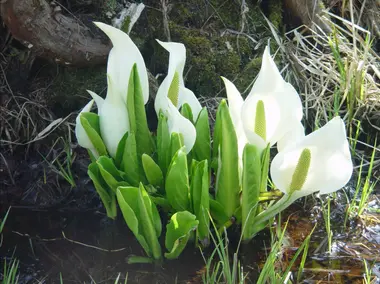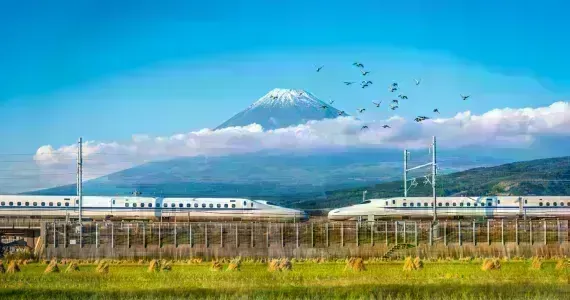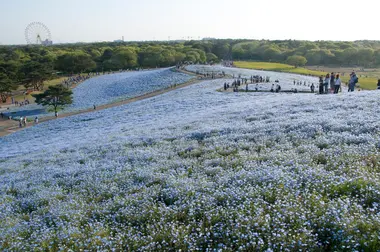Spring flowers to see in Japan
In springtime, it's not just cherry trees that bloom in Japan! Discover all the other flowers that bloom between March and June!
While spring in Japan is synonymous with cherry trees, there are many other flowers that are very popular throughout the archipelago. Contact with nature is an important part of Japanese culture, which is why Hanami, or flower-watching, is a must if your trip takes place in spring. Every year, and for centuries, many Japanese spend an afternoon with family and friends under the blossoming trees. The Hanami tradition is closely associated with cherry trees, but can also take place under other blossoming trees, such as plum (ume) or peach trees! In addition to this festival, many flowers thrive in fields, gardens or parks, which you can visit for a change from urban landscapes! Japan is famous for its Zen and traditional Japanese gardens, but there are also plenty of English or Western-style gardens. These are the places where you can admire spring flowers, from Hokkaido to Kyushu!
The flowers we present here are in order of bloom!
- Kawazu zakura (February)
- Plum (February-March)
- Cherry / Sakura (March-April)
- Tulips (March-April)
- Mizubasho (April)
- Omuro-zakura (late April)
- Shibazakura (April-May)
- Azaleas (April-May)
- Glycines (April-May)
- Nemophila (April-May)
- Iris (April-May)
- Roses (May-June)
- Hydrangeas (June)
Kawazu Zakura
This variety of sakura is famous for its early flowering, as early as February! This makes for a magnificent sight, even for travelers who plan to visit the archipelago before the start of spring!
When? As early as February
Our favorite spot: The Kawazu zakura matsuri in Kawazu town is the most famous place to admire the Kawazu Zakura. The cherry trees are arranged around a small river that runs through the town, also known for its onsen.
Plum trees
The first flowers to announce the start of spring are those of the plum tree! Plum trees (or ume in Japanese) bloom in a variety of different colors, usually bright, and fill the air with a delicious fragrance. You can admire the beauty of plum trees all over the city, even in Tokyo and Kyoto.
When to pick? February - March
Our favorite spot : In the heart of the Japanese garden Kairaku-en, in the city of Mito, Ibaraki, over 100 varieties and 3,000 plum trees bloom in an enchanting spectacle during the Mito ume and yoru ume festivals, where you can observe them at night.
Find out more: Where to see plum blossoms in Tokyo?
Cherry blossom / Sakura
Cherry blossom season is often referred to as the most beautiful time to travel to Japan.
The petals of the Japanese cherry blossom, shaped like a heart, are the palest shade of pink, almost white. From late March to mid-April, they cover the archipelago in clouds of pink. Their short, magnificent bloom symbolizes the ephemeral nature of life, a notion deeply rooted in Japanese culture. Called sakura in Japanese, the flowers of this tree have become one of the archipelago's most famous symbols over the centuries.
When to visit? March - April
Our favorite spot: From Kyoto to Nara, via Tokyo, all the major cities offer parks and riverside promenades where you can admire the cherry trees and celebrate Hanami! We suggest Kanda-gawa Shiki no Michi, in Tokyo, a superb, little-known, calm and serene spot just five minutes from Higashi-Nakano station.
Discover all the places where you can admire the sakura in bloom!
Tulips
A product of the close relationship between the Netherlands and Japan for hundreds of years, tulips can be found by the thousands from the north to the south of the country, blooming beautifully in a rainbow of colors.
When do they bloom? March - April
Our favorite spot : Tonami Tulip Park, in Toyama Prefecture, with its two million tulips of 600 different species, is Japan's most famous place to see them. About an hour from Kanazawa, discover the park's great tulip avenues and floral arrangements!
Mizubasho
These small, white, lantern-like flowers grow naturally everywhere in Japanese forests and natural areas.
When are they available? April
Our favorite spot: Haradani Garden, near Kyoto, is a great place to admire these discreet white flowers.
Omuro zakura
Unlike Kawazu zakura, Omuro zakura is a late-blooming cherry variety!
When does it bloom ? Mid to late April
Our favorite spot: in Kyoto, Ninnaji temple is home to many of these little trees.
Shibazakura
Also known as “lawn cherry”, these little flowers grow low to the ground and adorn the landscape in a sublime mantle of pink, ranging from the palest, almost white, to the brightest! Spring is the ideal time for these pink fields to bloom.
When are they in bloom? April - May
Our favorite spot: Fuji Shibazakura Matsuri in the town of Fujikawaguchiko is a festival held in front of Mount Fuji, where you can admire both this mythical Japanese mountain and the magnificent fields of shibazakura flowers!
Azaleas
The Japanese azalea is a flowering bush that comes in a wide variety of colors. These bushes are often placed on hillsides, but can also be admired in temples and city parks. The landscape is transformed by these delicately petaled flowers, which bloom in the middle of the spring season.
When do they bloom? April - May
Favorite spots : Every spring, the Nezu Shrine hosts the Azalea Festival(bunkyo tsutsuji matsuri). Located north of Tokyo, the shrine boasts over 100 varieties of these flowers (including some very rare species!) in an area of over 6,000 square meters! Ashikaga Park not only boasts a magnificent array of wisteria, but also impressive fields of red azaleas. In Tokyo, the Shiofune Kannonji temple puts on a fabulous show in spring, with several thousand azaleas in every color. Finally, the Katsuragi Kogen near Nara, at the top of Katsuragi Mountain, turns red as the azaleas bloom.
Explore flowers across Japan!
Wisteria
Also called Fuji in Japanese, wisteria is a flowering tree much appreciated in Japan for its large clusters of soft pastel flowers.
When to grow? April - May
Our favorite spot : Visit Ashikaga Floral Park to admire the breathtaking cascades of wisteria flowers. This park even offers the chance to observe the blossoming of a variety of impenetrable wisteria, including yellow, white, and pink! Here's a tip: illuminated at night, they're even more spectacular. You can easily get there from Tokyo station on the Shinkansen Yamabiko.
Nemophila
These small, pale-blue flowers bloom in large areas like fields, all over Japan, like a wave of blue. Often surrounded by other flowers or wild nature, nemophila are a little-known yet magnificent flower that blooms in the spring season! Many gardens and parks have blue fields of this flower, so don't hesitate to discover them!
When does it bloom? April - May
Our favorite spot: Hitachi Kaihin Park, north of Tokyo in the Ibaraki prefecture, boasts splendid fields of nemophila. On the garden's website, you can see just how much the flowers have bloomed!
Iris
Many irises bloom in spring in Japan. You'll find both large iris plants and smaller, bushy Japanese irises.
When? April-May
Our favorite spot: Odawara Castle boasts a magnificent display of irises, as well as hydrangeas under the castle. You can also admire them at night, when soft lighting beautifully highlights them.
Find out more: Discover Japanese irises
Roses
Not the flower you'd expect to see in Japan, but there are plenty of rose gardens across the archipelago! Roses can bloom from May through to summer, and sometimes even into November depending on the variety, making them one of the easiest flowers to admire.
When are they in bloom? May - June
Our favorite spots : The Keisei Rose Garden in Chiba boasts over 10,000 rose plants and more than 160 different varieties! In Tokyo, we recommend two gardens: Kyu-Furukawa Gardens and Imperial Garden Park, with its resplendent rose garden.
Hydrangeas
The color of hydrangeas is often associated with the blue skies of springtime, but it's the parterres of white, blue, green, violet and pink petals that they offer us. Their bloom brings the spring season to a close and heralds the start of the summer season!
When are they in bloom? June and summer
Our favorite spots: To admire them, we recommend the Meigetsuin temple, also known as Ajisai-dera (the hydrangea temple), in the city of Kamakura. In Kyoto, the Mimurotoji is a particularly pretty temple, with many hydrangeas in bloom. Much further north, in Akita, the Unsho-ji, with its flowerbed, is one of the most beautiful places to contemplate hydrangeas.





























